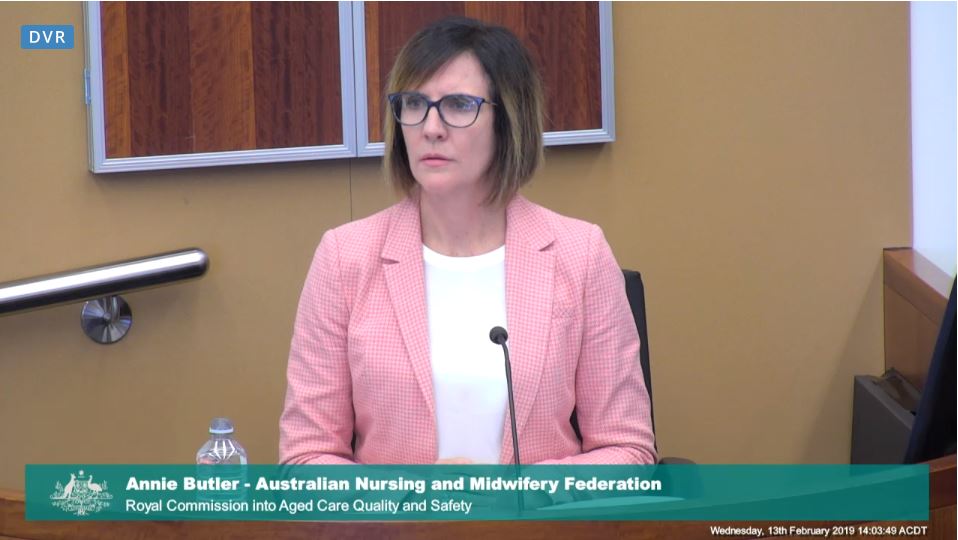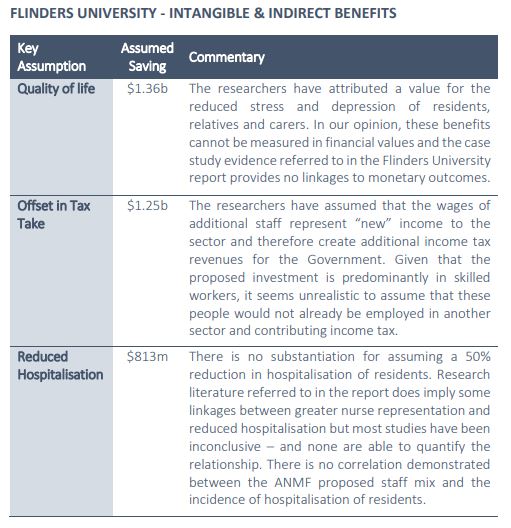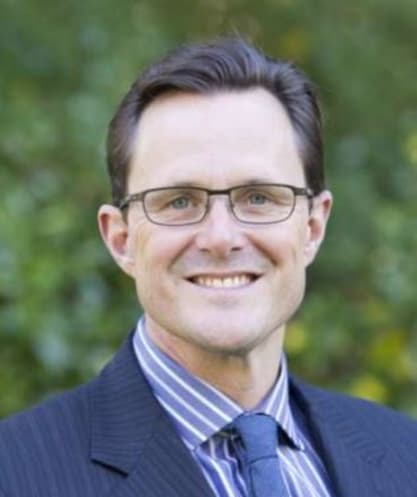The 2017 economic analysis on staffing and skills mix in aged care by the University commissioned by the Australian Nursing and Midwifery Federation (ANMF) was based on “little empirical data to support the material assumptions used, nor the forecasted impacts of the ANMF’s proposed staffing ratios”, according to a new submission made by aged care advisors Ansell Strategic to the Royal Commission.
You can download the full submission HERE.
Featuring a 1917 quote from American journalist H.L. Mencken 1917 on its cover – “For every complex problem, there is a solution that is neat, simple and wrong”, the Ansell submission concludes staff-to-resident ratios are “not appropriate” for residential aged care.

Nurses’ union pushed Royal Commission for set staffing mix
The ANMF’s Federal Secretary Annie Butler (pictured above) had heavily spruiked the staffing mix model – which aims to provide residents with 4.3 hours (four hours and 18 minutes) of care a day by 2025 and a 30% RN, 20% EN and 50% PCW minimum – during her evidence to the Royal Commission back in February.
Counsel Assisting Paul Bolster seemed interested in the findings of the 2017 report, which had recommended a 240% increase in full time equivalent (FTE) nurses and nursing hours to increase from 25% to 50% of the workforce.
But Ansell’s Managing Director Cam Ansell says combined with the minimum hours requirement, this would require an extra 57,000 FTE nurses – an unrealistic demand for a sector that only employs around 24,000 FTE nurses now.
The economic analysis by Flinders University also reported while the ANMF’s plan would cost a total of $5.7 billion, this would be offset by indirect and social benefits.

However, Ansell’s 16-page report – which also relied on an examination of international research and interviews with ‘Care Leaders’ from over 160 private and Not for Profit homes – has undercut those findings, saying the ANMF and Flinders University financial modelling “does not substantiate the assumptions underpinning the forecast economic and social benefits” (pictured top).
Little to back up assumptions in ANMF report
Ansell points to six areas where the case presented in the ANMF report doesn’t cut the mustard:
- Variability of Resident Needs and Staff Skills – the advisory firm found there was little support for fixed staff ratios in any of the studies cited by the ANMF. Instead Ansell says most of the studies concluded resident outcomes were impacted by a range of circumstances and environmental factors.
- Overinvestment in Clinical Resources – “Both the international and ANMF research highlights that the greatest investment (missed care events) is required in personal care tasks and activities of daily living which would not ordinarily require the clinical expertise of a nurse,” the Ansell report notes.
It finds that the 30%/20%/50% ratio (pictured below) recommended by the ANMF would divert more costly clinical care staff to non-clinical tasks.
- Evolving Models of Care – Ansell adds that the ANMF has argued that fixed staffing ratios have been successful in achieving good patient outcomes in hospitals without examples from international practice to back their case.
“This report demonstrates the dangers of adopting simplistic assumptions across sectors that are not the same,” the Ansell submission states bluntly, pointing to flexible rostering as key to delivering person-centred care: “Residential aged care is a home, not a hospital.”
- Scarcity of Registered and Enrolled Nurses – noting the Royal Commission has dampened interest in the sector, the Ansell report argues it will require a major national drive to increase enrolments of new nurses just to keep up with the demands required for Australia’s ageing population.
“It is not possible to source the 57,000 new nurse FTE’s proposed by the ANMF, nor is it appropriate to roster these scarce resources to arbitrary ratios and non-clinical roles,” it states.
- Economic and Administrative Burdens – Ansell also says there is little data to back the ANMF’s claims that ratios would offer improved quality of life for residents and carers, create new income tax revenues for the Government or reduce hospitalisation rates for residents – and the ANMF’s research partner Flinders University acknowledges this:
“The University concedes there is little direct evidence to underpin the key assumptions used in the modelling. Our discussions with the authors of the Flinders University study confirmed that there is little empirical data to support the material assumptions used.”
- Implications for Consumer Choice – the Ansell submission adds that staff ratios will also prevent any reform towards making care ‘portable’ between the home and residential care as put forward in the Aged Care Roadmap.
“Introducing staff ratios will inhibit any future reform towards person-centred, flexible aged care services,” it states.
It’s a damning report. In short, Ansell has revealed that the ANMF has essentially built their house on sand.
To us, it shows how prepared the union is to bend the landscape to support their cause – will the Commissioners take the same view?











